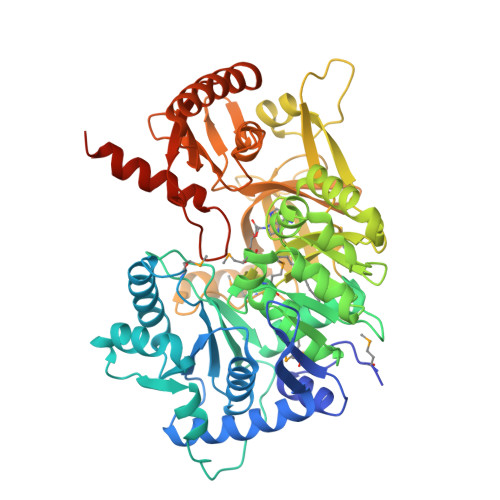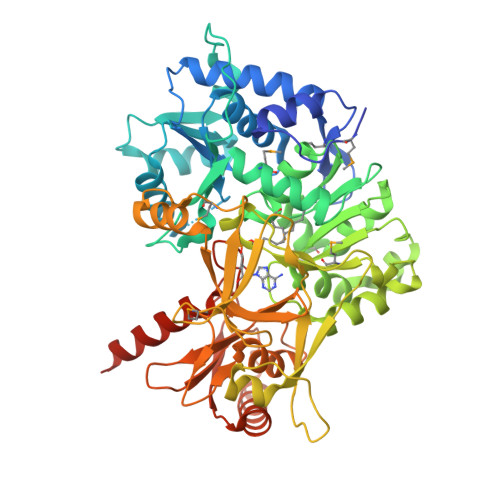Structural and Functional Studies of Fatty Acyl Adenylate Ligases from E. coli and L. pneumophila.
Zhang, Z., Zhou, R., Sauder, J.M., Tonge, P.J., Burley, S.K., Swaminathan, S.(2011) J Mol Biology 406: 313-324
- PubMed: 21185305
- DOI: https://doi.org/10.1016/j.jmb.2010.12.011
- Primary Citation of Related Structures:
3KXW, 3LNV, 3PBK - PubMed Abstract:
Fatty acyl-AMP ligase (FAAL) is a new member of a family of adenylate-forming enzymes that were recently discovered in Mycobacterium tuberculosis. They are similar in sequence to fatty acyl-coenzyme A (CoA) ligases (FACLs). However, while FACLs perform a two-step catalytic reaction, AMP ligation followed by CoA ligation using ATP and CoA as cofactors, FAALs produce only the acyl adenylate and are unable to perform the second step. We report X-ray crystal structures of full-length FAAL from Escherichia coli (EcFAAL) and FAAL from Legionella pneumophila (LpFAAL) bound to acyl adenylate, determined at resolution limits of 3.0 and 1.85 Å, respectively. The structures share a larger N-terminal domain and a smaller C-terminal domain, which together resemble the previously determined structures of FAAL and FACL proteins. Our two structures occur in quite different conformations. EcFAAL adopts the adenylate-forming conformation typical of FACLs, whereas LpFAAL exhibits a unique intermediate conformation. Both EcFAAL and LpFAAL have insertion motifs that distinguish them from the FACLs. Structures of EcFAAL and LpFAAL reveal detailed interactions between this insertion motif and the interdomain hinge region and with the C-terminal domain. We suggest that the insertion motifs support sufficient interdomain motions to allow substrate binding and product release during acyl adenylate formation, but they preclude CoA binding, thereby preventing CoA ligation.
Organizational Affiliation:
Biology Department, Brookhaven National Laboratory, Upton, NY 11973, USA.





















